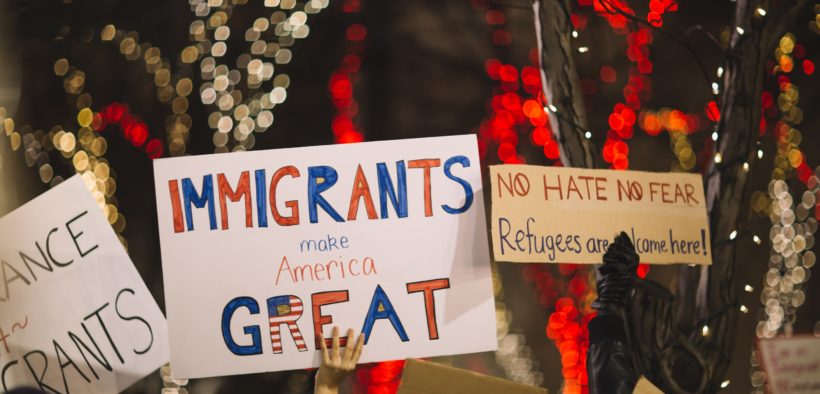Supreme Court Case Trump v. Hawaii and the Relevance of the 1st Amendment
Share

Image Credits: @nitishm on Unsplash (Unsplash License)
The Supreme Court case Trump v. Hawaii showcases the authority presidents have over the laws of the country, especially in regards to immigration policies. In 2017, former President Donald Trump issued an order to prohibit immigration into the United States from countries with the primary practiced religion of Islam. This executive order led to the case Trump v. Hawaii. However, this is not the first instance of discriminatory policies being established in the United States. In fact, the United States has a long history of divisive orders. Not only did this executive order raise concerns of discrimination and anti-immigrant sentiment that exists in the United States today, but it also brings into question powers of established political institutions such as the presidency.
The United States has had a long history with discriminatory immigration policies that are important to consider when examining the nature of Trump v. Hawaii. For example, in 1882, the United States established the unjust Chinese Exclusion Act, which banned Chinese immigrants from the United States. This Act demonstrates how much progress still needs to be made in the country to create an accepting environment for all.
The immigration ban under the Trump Administration was established in an attempt to ‘protect American security.’ However, this was based on false and generalized beliefs that those who practice Islam dislike America and that the threat of terrorism posed by immigration from predominantly Muslim countries would destabilize American security. Because of these beliefs, Donald Trump issued Executive Order No. 13,769 (EO-1). This order officially banned the entry of immigrants from Muslim majority countries to the United States for 90 days. This travel ban was created for individuals from “Iran, Iraq, Libya, Somalia, Sudan, Syria, and Yemen–and suspended the resettlement of all Syrian refugees.” Trump viewed the Syrian state as a national security threat due to the conflict in the region. Due to the discriminatory nature of the order, protests began to form across the country, which consequently led to the review of the order by the federal district court of Hawaii. With public disapproval, the court opted to remove this order; however, a new order quickly followed with support of the court: Executive Order No. 13,780 (EO-2) which officially ban the entry of immigrants from Muslim majority countries to the United States. On March 6th, 2017, Donald Trump expanded the original executive order, essentially lengthening the duration of the travel ban. The discriminatory nature of the executive orders led to Trump v. Hawaii being heard in the Supreme Court. The policies enacted via the order actively discriminated against individuals of the Islamic faith who sought to escape the violence in their countries and attain security. The case of Trump v. Hawaii calls into question the constitutionality of travel bans and the implications of the First Amendment.
The case is focused on the First Amendment in regards to the power of the president when making national security decisions. The First Amendment of the United States Constitution addresses the rights to freedom of speech and freedom of religion. This Amendment is particularly important as it allows individuals to practice their religion freely, without state intervention. Within the First Amendment, there is the Establishment Clause which, “prohibits the government from ‘establishing’ a religion.” This is crucial to ensure individuals have the liberty to practice any religion of their choosing. Additionally, because of the case’s relevance to immigration policy, the Immigration and Nationality Act is of high importance. This clause ultimately declares it to be unconstitutional to discriminate against any individual for practicing their religion, which in the United States could be designated more specifically towards individuals of the non-Christian faith. In addition to the Establishment Clause, the case was strongly related to the Immigration and Nationality Act of 1965. Prior to this act, the United States had a quota system established through Immigration Act of 1924. In 1924, the country utilized quotas to create a set limit on the number of immigrants entering the United States, allowing some but not all immigrants to enter the country. This system, “provided immigration visas to two percent of the total number of people of each nationality in the United States.” Due to the Immigration Act’s discriminatory policies, demonstrated through unequal entry allowances and representation for different ethnic groups, the Immigration and Nationality Act was passed in 1965 and created more opportunities for individuals to immigrate to the United States through employment and family connections.
In 2018, “three individuals with foreign relatives affected by the entry suspension, and the Muslim Association of Hawaii,” challenged the new Trump policies. The plaintiff argued that these Orders were unconstitutional on the basis of the Immigration and Nationality Act and the Establishment Clause of the First Amendment. The case began in a federal district court in Hawaii and eventually made its way to the Supreme Court of the United States. However, in the end, the Supreme Court came to the conclusion that this order lay within Donald Trump’s jurisdiction at the time as President of the United States, due to his justification of protecting American national security. Despite the 5-4 ruling on the case, some justices still saw the problems with keeping the ban in place, most notably Justice Ruth Bader Ginsberg, who stated that the ruling “repeats tragic mistakes of the past and denies countless individuals the fundamental right of religious liberty.”
However, even more recently after Trump v. Hawaii, there have been cases that exhibit the necessity for significant changes to occur in society such as the Mayorkas v. Innovation Law Lab which established the obligation for asylum seekers to “remain in Mexico.” Additionally, in the case of the United States v. Vaello-Madero in 2021, Puerto Ricans were left out of the Supplemental Security Income program. Despite the progress made by the United States, there are still changes needed to be made to ensure all individuals have accessibility to equal services and rights to ensure a more equitable future for the United States
Ultimately, the Supreme Court case Trump v. Hawaii represents the authority Presidents have over immigration policy and their jurisdiction over national security protocol. However, these cases need to be further evaluated to ensure that the freedoms of individuals are being upheld. With President Biden’s current initiatives, many of former President Donald Trump’s policies have been eliminated allowing for more inclusive and just immigration for individuals across the globe. However, given the broad presidential authority over immigration, there will be a continued need to ensure that immigration policies are developed to support the liberty of individuals to practice religion independently.


Want to get involved?
Connect with us! Connect with us!